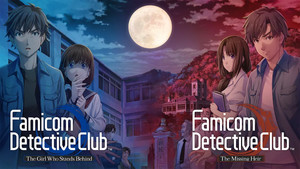Game Review
by Lynzee Loveridge,Famicom Detective Club: The Two-Case Collection
Nintendo Switch
| Description: |  |
||
Take on the role of a teen (and later young man) detective as a member of the Utsugi Detective Agency in two cases, The Missing Heir and The Girl Who Stands Behind. In both scenarios, you'll need to interview witnesses to decipher the truth. In The Missing Heir, a suspicious death of the matriarch in a small mountain town will bring to light long-kept secrets as the body count continues to rise. In the prequel The Girl Who Stands Behind, you'll need to investigate a ghost story at a high school that has mysterious connections to a recent disappearance. |
|||
| Review: | |||
This visual novel double-pack was released for English-speaking audiences for the first time on May 14, offering a shiny remake of Satoru Okada and Yoshio Sakamoto's adventure games for Nintendo. While this 2021 edition visually bears little resemblance to the originals released in 1988 and 1989, its gameplay still carries over, and that might prove to be the titles' biggest hurdle for new fans. Firstly, I technically played this out of order. The Missing Heir was released first, followed by the prequel The Girl Who Stands Behind. Now that I've completed both, I actually recommend playing them according to the games' chronological order because the pay off of ending the narrative with The Missing Heir is honestly better. I think if I had played them the other way around (i.e. the release order), I would have found the plot beats less fulfilling, even taking into consideration that the games probably weren't as predictable during their original release. That said, whichever order you decide to play is fine; you could even try out one and stop there, if you wanted. The real challenge here is if you can tolerate the gameplay. I'm using the term 'gameplay' here loosely. If you're at all familiar with the Ace Attorney franchise, it's a bit like that but far, far more tedious. You control the detective and have a limited number of menu options at any given location. They include choices like Talk, Show (an object to someone), Look/Examine (someone or something in the environment), Call Out/Engage (to speak with a different character in the same area), Remember, and Travel (to a different area). There's also Speculate which is only used at the end of each chapter to put together thoughts and come to conclusions about newly-gained information. It is not always evident which menu option the player should choose; sometimes it's a matter of logically following the flow of conversation, other times the player is selecting "Remember" to prompt the detective to think about the new information and draw a conclusion (that you probably already came to) to trigger the next part of the story. In a sense, much of the game is trying to deduce how to trigger the next event so that the story continues, and that might require exhausting every minute option to get there, including shouting at the ocean. This style of gameplay not only extends the time required for players to get through the meat of the story; it also limits how information is gained in a way that can sometimes feel unnatural. In The Girl Who Stands Behind, there is a structure on the high school campus that is central to the mystery. I was sure at some point I'd get to investigate the building. All of the clues were telling me from very early on that there was a corpse in there. When are we going to check to make sure there isn't someone dead in this old school building? When? NEVER. Why? This seems like Sleuthing 101. GO IN THE BUILDING! Both stories had some arbitrary info blocks like this, but even with my sus sense tingling, neither case went exactly where I expected it to go. I consider myself a well-versed detective game player, so I was happily surprised that even with the games' age and influence there were some tricks left up its storytelling sleeves. Visually, I really appreciated the new coat of paint on these titles. The character designs are distinctive and seem intentionally dated, like they want to refer back to the early 90s. There are some animation-like scenes that look really nice and the background art often features cute, animated details. I also appreciated that equal effort was put into character designs for generic people on the street as well as those central to the overall plot. The game is also fully voiced in Japanese, including the protagonist who is played by none other than the legendary Megumi Ogata. She lays on a soft, androgynous voice here that lends itself well to whomever you want to imagine the protagonist is. As far as adventure games go, Famicom Detective Club's two stories offer an interesting read with the caveat that both might have you throwing options at the wall to see what sticks. The game gives no real options to feel like you, personally, are solving the story by putting two and two together. Don't go into it expecting to have "Aha!" moments where your conclusions are rewarded through gameplay. This is a mystery that is more read than experienced. |
| Grade: | |||
|
Overall : B-
Graphics : A
Sound/Music : B
Gameplay : D
Presentation : B
+ Refreshed art looks nice, distinctive character designs, not too predictable despite games' age |
|||
|
discuss this in the forum (1 post) |
this article has been modified since it was originally posted; see change history |
|||